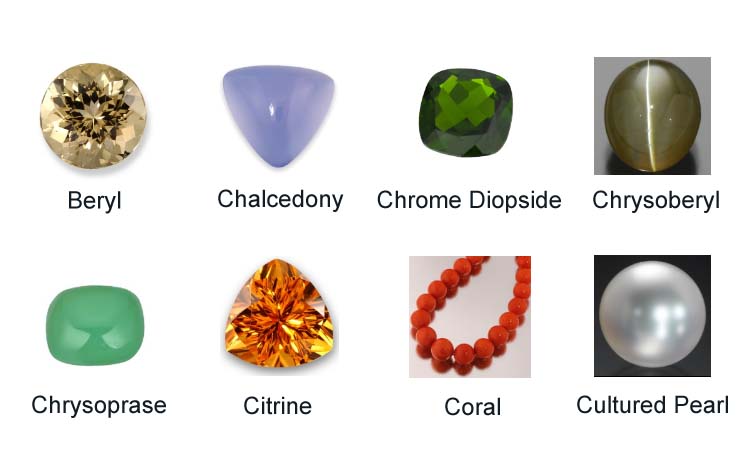
Beryl
The parent mineral of such varieties as aquamarine and emerald, beryl is made up of hexagonal crystals that can range from small deposits to formations several meters in size. Pure beryl is colorless, but natural variances bring out colors like green, blue, yellow, and red.
Chalcedony
Another parent gemstone with many children, chalcedony is a form of silica with a waxy, translucent appearance. Chalcedony has been used as far back as the Bronze Age to carve seals and other important artifacts, and many of its variants were also widely used along trade routes through Central Asia.
Chrome Diopside
A brilliant green gem, chrome diopside may not have the most elegant sounding name, but is one of the only stones capable of matching the allure of emerald. Affordable without compromising showmanship, chrome diopside is rich enough in color to make it unusable in large sizes as it becomes nearly opaque.
Chrysoberyl
The parent gem of alexandrite and cymophane, chrysoberyl is a strong, durable stone with a characteristic yellow-green hue. Discovered in 1790 by one of the most outstanding geologists of the time, Abraham Gottlob Werner, chrysoberyl is actually unrelated to the beryl gem, but because of this frequent confusion this unique geological occurrence is often overlooked in its own right.
Chrysoprase
A variety of chalcedony, chrysoprase has a characteristic apple-green hue and is composed of ultra-fine crystals that cannot be distinguished under normal magnification. Whereas other green gems including emerald and chrome diopside gain their green color from the presence of chromium, chrysoprase enjoys its spectral brilliance thanks to trace amounts of nickel.
Citrine
A rare natural variation of quartz, citrine exhibits a warm yellow coloring ranging from pale to a deep orange hue. Strong and durable, citrine is an excellent choice for jewelry, where its translucent brilliance catches wandering eyes. Citrine's coloring comes from small particles of iron embedded within the quartz, which oxidizes and gives citrine its characteristic lemon (in French, "citron”) color.
Coral
Another biogenic gem, coral comes from colonies of marine invertebrates whose exterior shell, made of calcium carbonate, can be fashioned into jewelry and other ornaments. The most popular coral gemstone is red coral, which exhibits a durable pink or red skeleton. Found mainly in the Mediterranean Sea, red coral is extremely soft, and is often made into beads.
Cultured Pearl
One of the only gemstones formed within a living organism, pearls have an iridescent, milky quality that the ancient Chinese associated with the power of the moon. Pearls are formed when mantle tissue in a mollusk is damaged, and nacre is secreted into the wounded area until it eventually hardens into a sphere.
The article comes from China Chang'an stainless steel jewelry manufacturer - A2A, the website is www.stainlesssteelacc.com .
Copyright © A2A All Rights Reserved | Sitemap